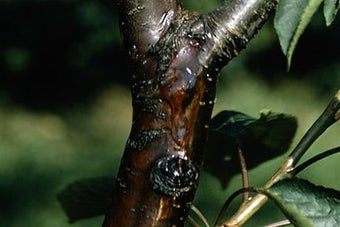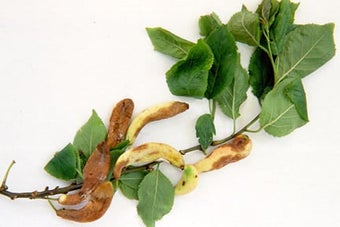
Quick facts
Common name - Silver leaf
Scientific name - Chondrostereum purpureum
Plants affected - Plums, apples, apricots, cherries, Rhododendron and Laburnum
Main symptoms - Silvery leaves, branch dieback, wood staining
Caused by - Fungus
Timing - Infectious spores are active from September to May
What is silver leaf?
Silver leaf is a fungal disease caused by Chondrostereum purpureum. It infects through wounds, mainly caused by pruning. Leaf silvering occurs during summer and fruiting bodies form from late summer.
The trees affected most commonly are plums, apples, apricots, almonds, cherries and relatives, hawthorns, roses and poplars. Rhododendronand Laburnumare also attacked, though in neither of these does the silvering symptom develop in the leaves.
Symptoms
You may see the following symptoms:
- On leaves: Leaves develop a silvery sheen, especially noticeable in plums but less so in other trees. Following the appearance of the silvery sheen, affected branches die
- On branches: When affected branches are cut across, an irregular dark stain may be seen in the centre, not necessarily corresponding to the heartwood. On older dead branches, bracket-shaped fungi appear. These have a whitish woolly upper surface and a purple-brown lower surface with fine pores
- On rhododendrons: Long strips of dead bark may spread back from the point of entry
Similar silvering symptoms in leaves may sometimes develop as a result of cold, drought or other non-disease forms of stress. This is known as 'false silver leaf' and can be told apart from silver leaf disease by the absence of staining in the wood.

Control
Non-chemical control
Since the fungus produces most of its infectious spores in autumn and winter, ideally carry out routine pruning of susceptible plants in summer. Not only are there fewer spores at this season but pruning wounds, the main point of entry for the spores, heal more quickly.
Where silver leaf develops the affected branch should be removed as soon as possible, certainly before the fungal fruiting bodies appear. The branch should be cut off, where possible, at a point 10-15cm (4-6in) beyond the area where the staining in the internal tissues ceases. Cutting equipment should be disinfected regularly. Dispose of the pruned material immediately, as fruiting bodies will still form if it is left lying around.
Chemical control
We no longer recommend binding, wrapping or painting pruning cuts as standard practice; the best thing is to let them heal naturally. However, where silver leaf is a recurring problem, painting wounds of susceptible trees might be the less harmful option.
Laburnum, poplar, Prunus and rhododendron are examples of susceptible plants where protective wound paints such as Growing Success Prune and Seal, Provanto Arbrex Seal and Heal or Vitax Medo might be worthwhile.
Biology
The airborne spores of this fungus are released from the bracket-shaped fruiting bodies found on dead branches. These spores infect healthy branches through wounds, especially pruning cuts. The fungus grows down into the wood and kills it, producing a dark stain.
The silvery sheen in the leaves is caused by a toxin produced by the fungus and carried upwards in the sapstream to the leaves. This toxin causes the leaf tissues to separate, with the result that an airspace forms, giving the leaf a silvery appearance. The fungus is not actually present in the leaves, but shortly after the appearance of the silver colour, the branch dies. Fruiting bodies of the fungus grow out later from the dead wood and the cycle starts again.
Spores are released mainly in the autumn and winter months under damp conditions. This is why it is always recommended to prune susceptible trees in summer when silver leaf spores are less abundant.






